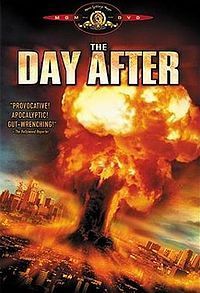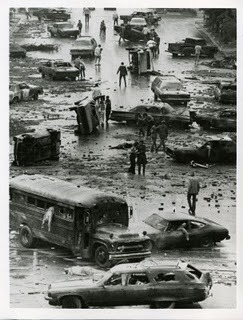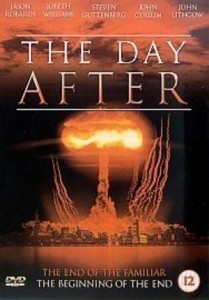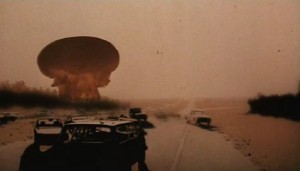The Day After
Several months late, but here's the second in my series of looks at classic (and not so classic) post-apocalyptic movies.
 Picture the scene: late-1983 – a very different, pre-Internet world where news comes almost entirely from the daily papers and scheduled radio and TV bulletins, where information isn't available 'on tap' like it is today. It's a world which feels like it's permanently on the edge; split into east and west by two opposing superpowers with their respective leaders' fingers hovering over the buttons which, it seems, will inevitably release a nuclear Armageddon sometime very soon. In school playgrounds, kids talk nervously about things like Mutual Assured Destruction and what they're going to do when the four-minute warning sounds. There's an uneasy feeling of impending doom, and the lack of readily available information makes the playground chatter that much more frightening… 'your eyes melt if you look at one of them exploding', 'they'll aim at least three at our city, we won't have a chance', 'I heard Dad talking to one of his mates about the missiles at Greenham Common'…
Picture the scene: late-1983 – a very different, pre-Internet world where news comes almost entirely from the daily papers and scheduled radio and TV bulletins, where information isn't available 'on tap' like it is today. It's a world which feels like it's permanently on the edge; split into east and west by two opposing superpowers with their respective leaders' fingers hovering over the buttons which, it seems, will inevitably release a nuclear Armageddon sometime very soon. In school playgrounds, kids talk nervously about things like Mutual Assured Destruction and what they're going to do when the four-minute warning sounds. There's an uneasy feeling of impending doom, and the lack of readily available information makes the playground chatter that much more frightening… 'your eyes melt if you look at one of them exploding', 'they'll aim at least three at our city, we won't have a chance', 'I heard Dad talking to one of his mates about the missiles at Greenham Common'…
I was one of those kids becoming increasingly pre-occupied with the end of the world. I kept a scrapbook of articles on the subject torn from newspaper and magazine pages, and when I heard about a TV movie being shown in the US which would show the effects of a nuclear strike on a city in Kansas, I knew I had to watch it. I persuaded my parents to let me stay up late for the UK premier, feeding them some spiel about needing to watch it for a project at school. Although it had nowhere near the impact which THREADS would later have on me, THE DAY AFTER was still startling viewing at the time.
 Like THREADS, THE DAY AFTER portrays the after-effects of a nuclear attack through the eyes of a shattered community, focusing on several individual groups of characters: a doctor caught in traffic as the bombs strike, a farmer's family preparing for their eldest daughter's wedding, a serviceman stationed at a missile silo, a hitchhiker trying to get home from college before the unthinkable happens…
Like THREADS, THE DAY AFTER portrays the after-effects of a nuclear attack through the eyes of a shattered community, focusing on several individual groups of characters: a doctor caught in traffic as the bombs strike, a farmer's family preparing for their eldest daughter's wedding, a serviceman stationed at a missile silo, a hitchhiker trying to get home from college before the unthinkable happens…
As you'd expect, the missile attack forever changes the lives of each of these groups of people. Dr Russell Oakes (played by respected character actor Jason Robards) manages to walk ten miles away from the devastated Kansas City and reaches the university hospital in Lawrence where, with others, he begins the impossible task of trying to care for thousands of injured survivors with limited staff and resources. Airman Billy McCoy is able to escape the initial effects of the blast, but after emerging from his bunker and scavenging for food, he succumbs to radiation sickness. Famer Jim Dahlberg and his family escape the blasts by sheltering in their cellar, although their son is blinded. A hitchhiking student, Stephen, (Steve Guttenberg in an early role) finds the family by chance. When Dahlberg's daughter flees the shelter, Stephen chases after her and brings her back to the cellar, but not before both of them have received a lethal dose of radiation.
As the film progresses, the sense of hopelessness increases. Virtually all of the characters either become sick or are killed. Food and medical supplies quickly run out or are contaminated. Almost all livestock are dead. The ground is poisoned and nothing will grow. What's left of society breaks down with frightening speed: law and order ceases to exist, mob rule and brutality taking its place.
Back in 1983, THE DAY AFTER had a huge impact. Its much heralded premier garnered record viewing figures in the US, with networks operating telephone helplines to calm terrified viewers. And watching the film again now with the benefit of history and hindsight, it's easy to understand why. Back then, there were times when nuclear war felt like a probability rather than just a possibility, and this was the first time Armageddon had been dramatized with such high production values. The movie (which was directed by Nicholas Meyer who had previously made STAR TREK II: THE WRATH OF KHAN), was aired with no commercials after the nuclear attack (either a planned move by the network or because no-one wanted to buy advertising time after the blasts, depending on who you believe). Perhaps the most telling anecdote about the film's power at the time, was the fact that it was believed to have had a major impact on both then-president Ronald Regan, and Mikhael Gorbachev.
Visually, THE DAY AFTER is a mixed-bag. Refused permission to use stock footage for the bomb blasts, the film-makers instead resorted to using plumes of oil filmed in water tanks which immediately dissipates the impact of some of the attack scenes. That apart, there are still plenty of visually arresting moments: draped with a blanket, the airman wanders through a forest as fallout drifts down around him like snow; the hitchhiker chases after the terrified farmer's daughter, both of them running through fields filled with dust-covered animal corpses; a school gymnasium – every visible square inch of floor space taken up by the dead and dying. There's a fair splattering of gore (for a 1980's US TV movie, anyway) and the effects of radiation sickness are portrayed effectively. The physical devastation of the town of Lawrence is very well done and to my mind THE DAY AFTER wouldn't have been half as successful had it not been for the obvious willingness of the town and its citizens to participate. During shooting they allowed their streets to be filled with burned-out cars. Shop windows were smashed and locals were used as extras, paid a few dollars more if they were prepared to shave their heads and not bathe to help convey the scale and reach of radiation sickness.
Almost 30 years later (now that's a scary thought) it's easy to forget the impact THE DAY AFTER had when it was originally made. Perhaps it's because I'm from the UK and I can relate more to working class families in Sheffield than the folks of Lawrence, Kansas, that I find it far less effective than THREADS. Maybe it's because it had a relatively well-known cast. I've been asked many times who I'd like to see play the lead in the forthcoming movie adaptation of HATER, and I always say I'd like to see an unknown as Danny McCoyne, because familiar faces can be a distraction. Jason Robards had been on the screen for more than 30 years before appearing in THE DAY AFTER, JoBeth Williams (who played Nurse Bauer) had been seen as the mom in POLTERGEIST the previous year, and Steve Guttenberg and John Lithgow (as a science professor) were already established actors. The end of the world doesn't need star names!
 There's a disclaimer in the closing credits which says something along the lines of 'this has been watered down for TV – if this happened, things would be far, far worse'. And that, I think, is the key difference between THE DAY AFTER and THREADS. THE DAY AFTER occasionally lapses into drama/soap territory with scenes of overly optimistic town meetings and the like. The implausible closing scenes of Jason Robards returning to the ruins of his home (literally a square space amidst acres of rubble) are almost like something out of THE BED-SITTING ROOM. The film feels compromised (it was watered-down from its original intended running length of four hours). THREADS, on the other hand, is unflinchingly bleak and dark, and is much better for it.
There's a disclaimer in the closing credits which says something along the lines of 'this has been watered down for TV – if this happened, things would be far, far worse'. And that, I think, is the key difference between THE DAY AFTER and THREADS. THE DAY AFTER occasionally lapses into drama/soap territory with scenes of overly optimistic town meetings and the like. The implausible closing scenes of Jason Robards returning to the ruins of his home (literally a square space amidst acres of rubble) are almost like something out of THE BED-SITTING ROOM. The film feels compromised (it was watered-down from its original intended running length of four hours). THREADS, on the other hand, is unflinchingly bleak and dark, and is much better for it.
I'd recommend getting hold of a copy of THE DAY AFTER. It's a good, not great, Post-Apocalyptic movie which had an undisputed impact on many, many people during those uncomfortable, unsettling days of the early 1980s.
If you're interested in reading more, there's a fascinating, in-depth critique of the movie here.
Next up in the Post-Apocalyptic Movie Club, animated old-aged pensioner Armageddon: WHEN THE WIND BLOWS
This is a post from David Moody's RSS feed. For regular updates about the HATER and AUTUMN books and films, subscribe to the feed today!
The Day After












